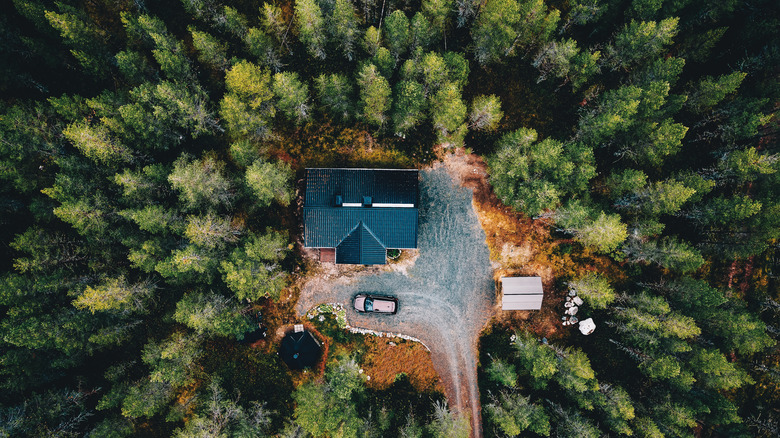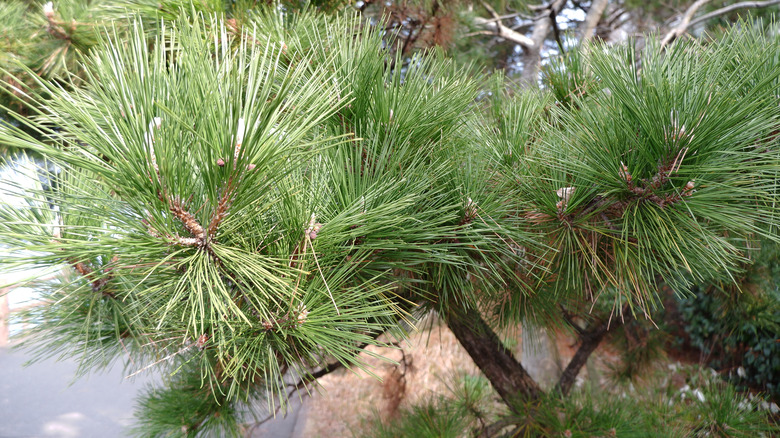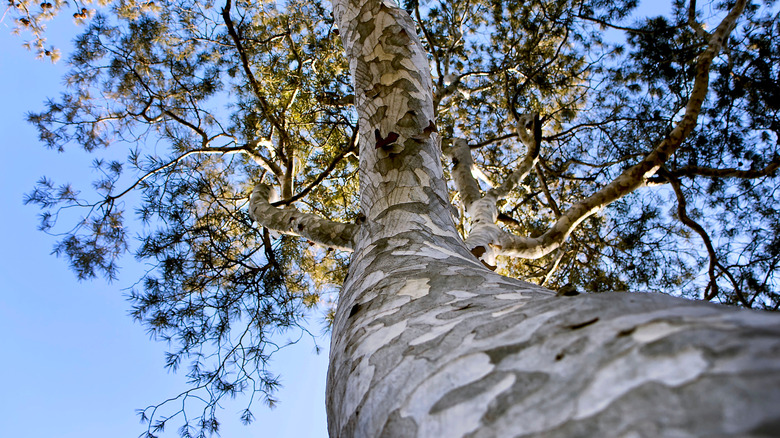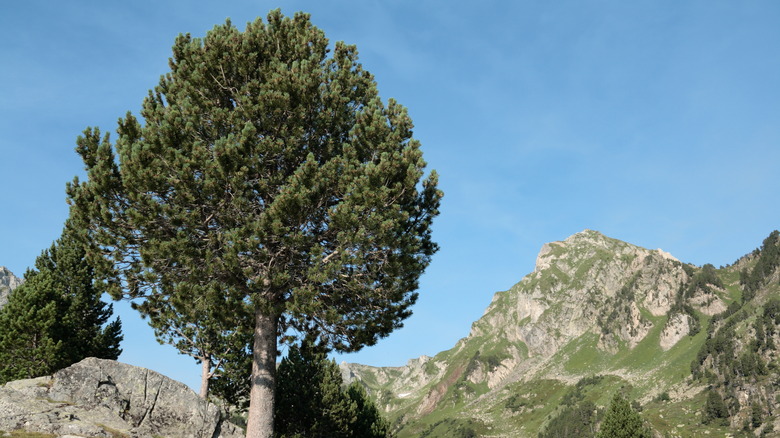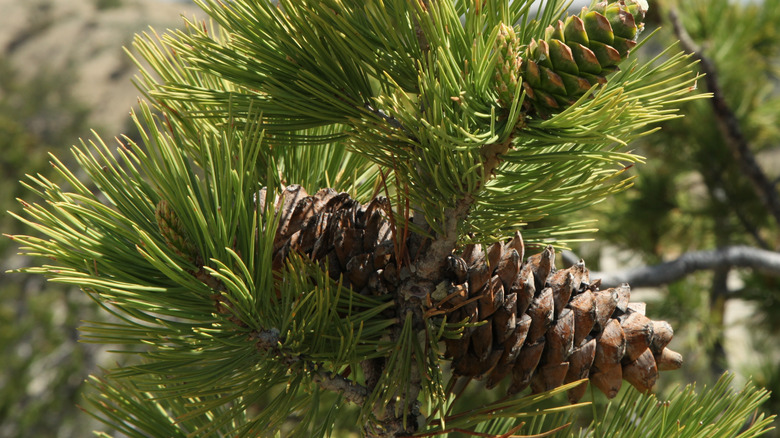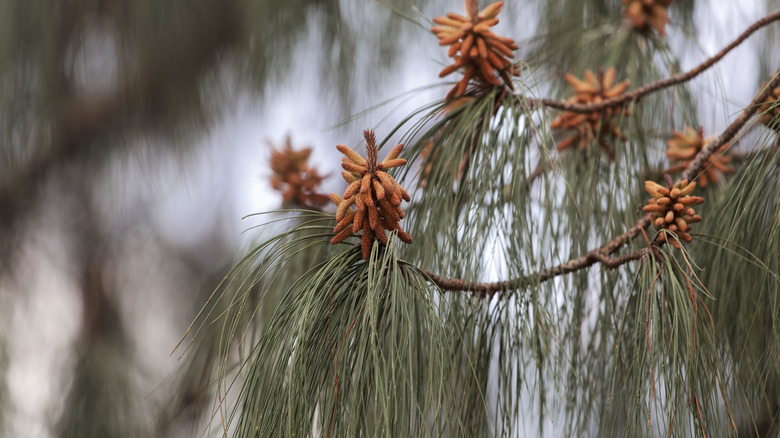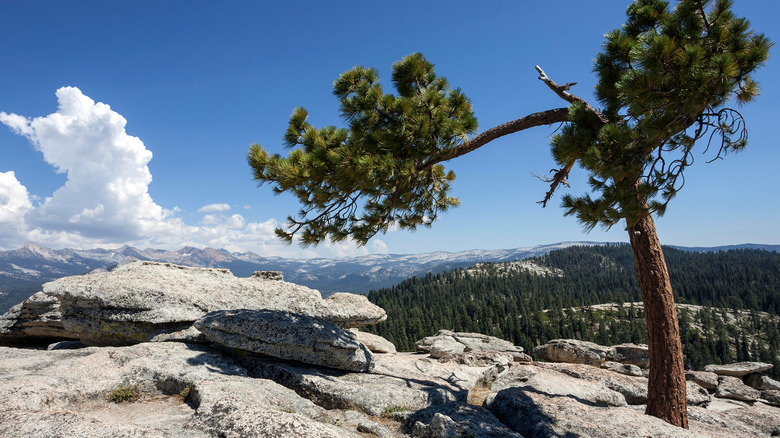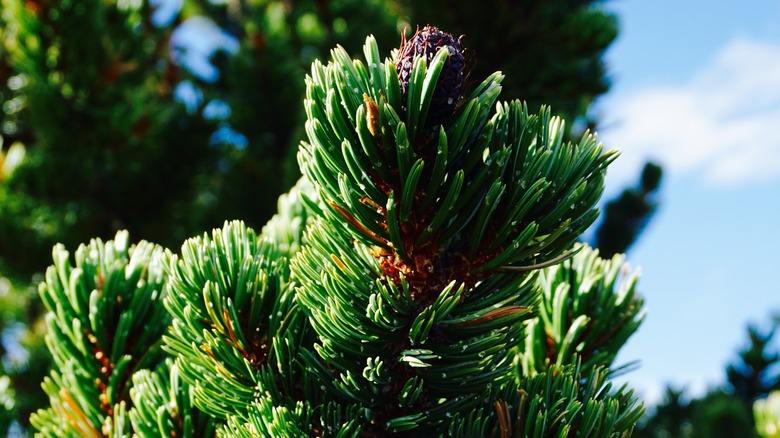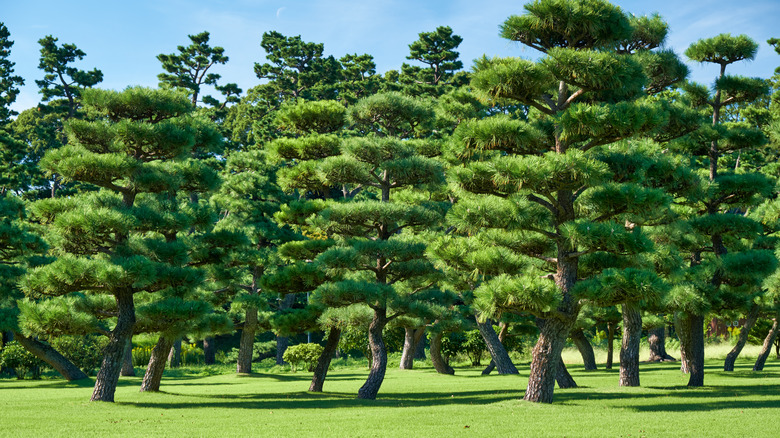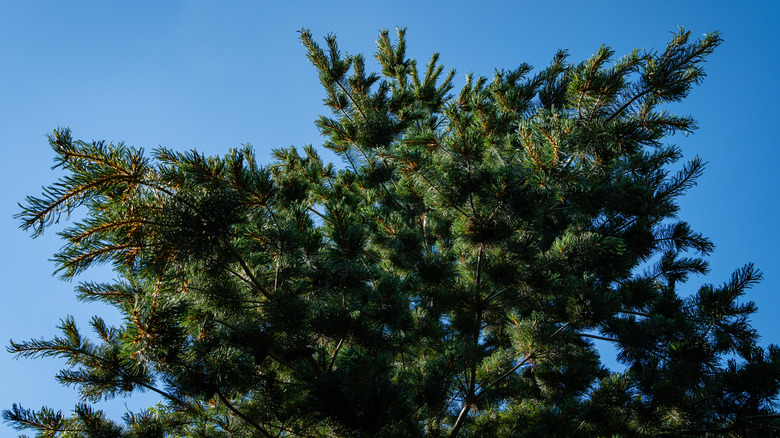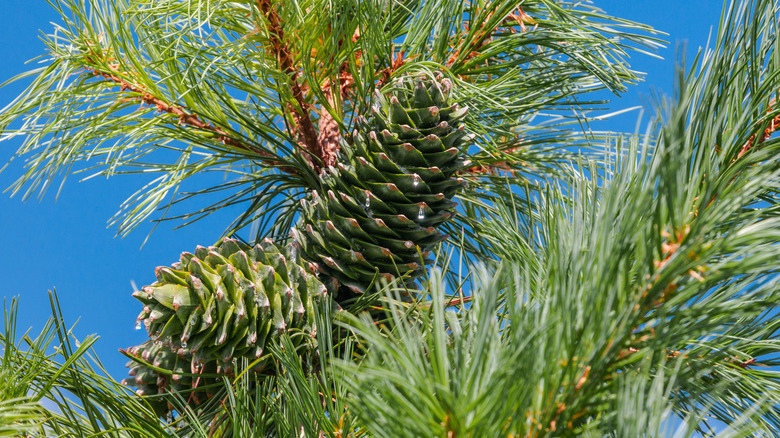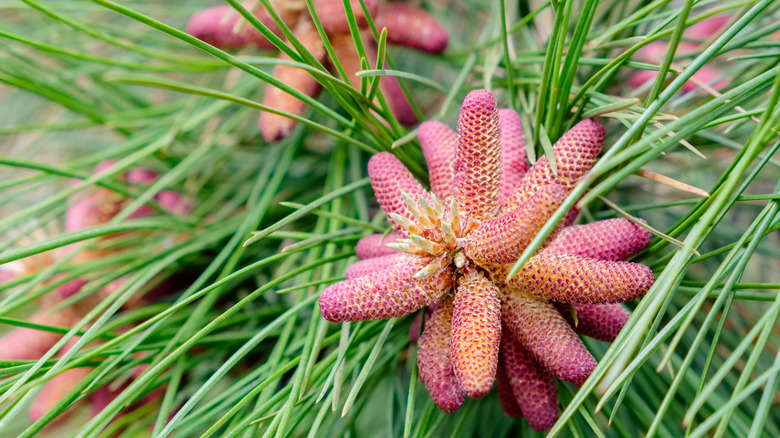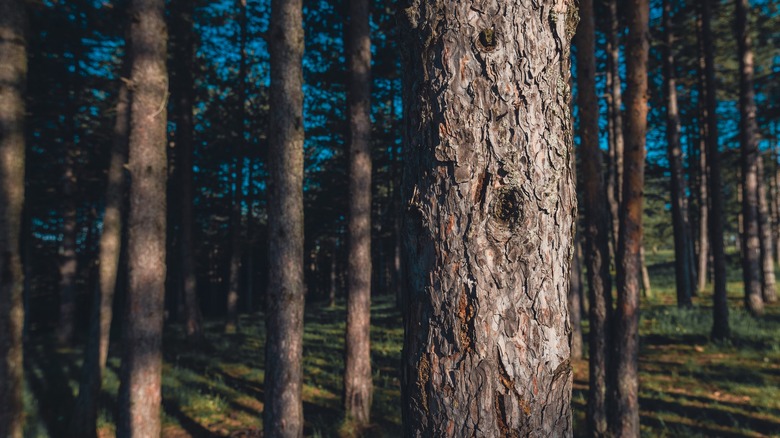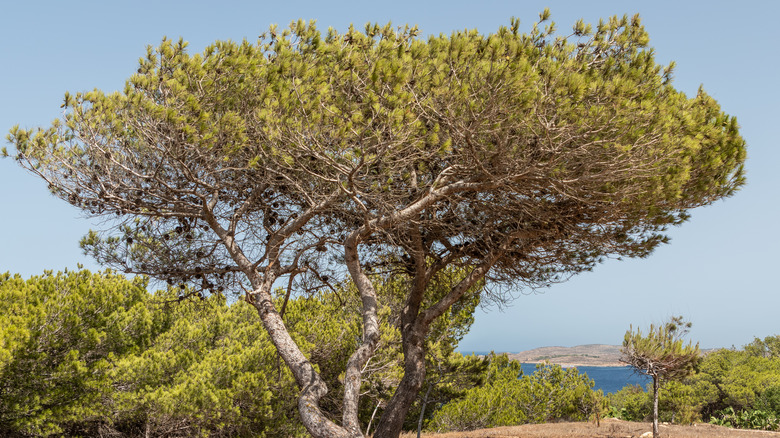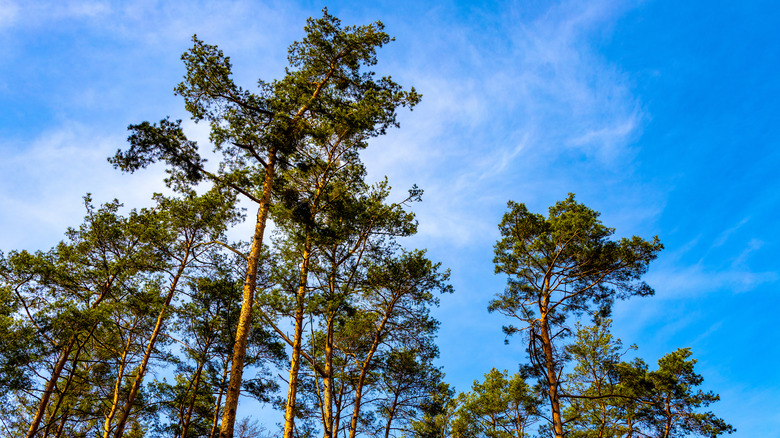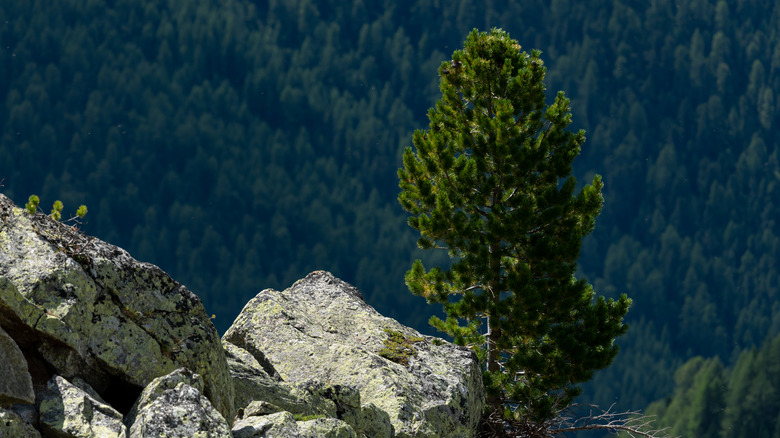15 Tall Pine Trees You Should Grow In Your Yard
Pine trees are a popular landscape plant around the world because their evergreen nature means you don't have to deal with pesky falling leaves or bare tree branches in the winter. They keep their dense, needle-like foliage all year long for interest throughout all four seasons. Thankfully, your pine tree options are not as limited as you might think. There are more than 100 different species that share similar traits but look very different from one another, as explained by the American Conifer Society. From unique options such as the Mexican weeping pine and Japanese black pine to more traditional trees like the lacebark pine and limber pine, there is an evergreen conifer that will be the perfect addition to your landscape.
Pine trees don't require very specific care when they are young or when they are established. They are known to be prolific growers as long as they are provided with some basic necessities such as a sunny location and well-draining soil. Before you decide which one you'd like to plant in your yard, make sure to consider your climate so your tree has the best chance at healthy growth and survival.
1. Coulter pine
The coulter pine (Pinus coulteri) is an evergreen conifer that grows to nearly 80 feet tall, as per Oregon State University. A warm-weather tree, this pine is native to the coast of California. Typically, it grows well in the high desert where it soaks up direct sunlight and resists wind and drought.
Bloom Season: Summer
USDA Growing Zone: 8 to 10
Growing Conditions: Full sun
Soil Type: Average and well-draining
Size: 33 to 79 feet tall
2. Lacebark pine
Lacebark pines (Pinus bungeana) are known for their wide growth habit and peeling bark that shows off patchy white spots, hence the common name. As this tree reaches adulthood, it becomes pyramidal or round due to its multi-stemmed branches. These features make the lacebark pine a wonderful specimen or accent planting in a carefully designed landscape, as told by North Carolina State Extension.
Bloom Season: Does not flower
USDA Growing Zone: 4 to 8
Growing Conditions: Full sun
Soil Type: Average and well-draining
Size: 30 to 50 feet tall and 20 to 35 feet wide
3. Swiss mountain pine
Swiss mountain pines (Pinus uncinata), or simply 'mountain pines', are coniferous trees that commonly grow in European countries that provide high altitudes and cooler temperatures. The American Conifer Society notes that this tree has a thick trunk that supports its tall height, which can be more than 3 feet in diameter.
Bloom Season: Does not flower
USDA Growing Zone: 5 to 10
Growing Conditions: Full sun
Soil Type: Well-draining
Size: 40 to 65 feet tall
4. Limber pine
Limber pines (Pinus flexilis) are common medium-sized landscape trees that are used in many states across America. A low-maintenance evergreen conifer, the limber pine grows best in places with high elevation around the Rocky Mountains, says Missouri Botanical Garden. It needs well-drained, gravelly soil and access to plenty of direct sunlight.
Bloom Season: Does not flower
USDA Growing Zone: 4 to 7
Growing Conditions: Full sun
Soil Type: Average and well-draining
Size: 40 to 60 feet tall and 25 to 40 feet wide
5. Mexican weeping pine
The Mexican weeping pine (Pinus patula) is named for its native range in the highlands of Mexico, as shown by the American Conifer Society. Since being discovered, the tree has been introduced to other continents, countries, and states with similar environments, including eastern and southern Africa, Brazil, and Hawaii. It is also named for its foliage, which hangs from the branches as if the tree were weeping, similar to a weeping willow tree.
Bloom Season: Spring and winter
USDA Growing Zone: 8 to 9
Growing Conditions: Full sun
Soil Type: Well-draining
Size: Up to 125 feet tall
6. Jeffrey pine
Jeffrey pines (Pinus jeffreyi) are a species of extremely tall pine trees that should not be planted in small yards that can't support their very tall growth habit. However, if you do have the space for this tree, it is a great addition to landscapes needing more upward interest. The Oregon State University mentions how the Jeffrey pine produces fragrant pine needles and twigs that smell of sweet lemons when crushed.
Bloom Season: Summer
USDA Growing Zone: 6 to 10
Growing Conditions: Full sun
Soil Type: Well-draining, sandy or gravelly
Size: 80 to 140 feet tall
7. Bristlecone pine
The bristlecone pine (Pinus aristata) is also sometimes referred to as the Colorado bristlecone pine, the hickory pine, or the Rocky Mountain bristlecone pine. According to the North Carolina State Extension, it is among the oldest trees on Earth and is loved for its manageable stature. Though it is considered shrubby compared to extra-tall pines, it is the perfect oversized addition to your small yard, reaching 20 feet in adulthood.
Bloom Season: Summer
USDA Growing Zone: 4 to 7
Growing Conditions: Full sun
Soil Type: Well-draining
Size: 8 to 20 feet tall
8. Japanese black pine
The Japanese black pine (Pinus thunbergii) is a popular lawn tree due to its strange growth habit, dense foliage, and moderately tall height. It is easy to care for, and it grows well in most U.S. states that don't experience very harsh winters. Monrovia states that this tree needs some specific care before it becomes established; however, a mature tree won't need regular attention.
Bloom Season: Does not flower
USDA Growing Zone: 5 to 10
Growing Conditions: Full sun to partial shade
Soil Type: Acidic and well-draining
Size: 10 feet tall and 15 feet wide
9. Japanese white pine
Japanese white pines (Pinus parviflora) are similar to Japanese black pines, but they grow much taller and need more sunlight. This tree with an irregular growth habit is frequently used as a specimen tree that enhances any garden with its dense foliage and fragrant needles, as said by the University of Florida.
Bloom Season: Flowers are insignificant
USDA Growing Zone: 4 to 7
Growing Conditions: Full sun
Soil Type: Acidic and well-draining
Size: 25 to 50 feet tall
10. Silveray Korean pine
The silveray Korean pine (Pinus koraiensis) is another popular evergreen pine tree that is native to Eastern Asia. It is characterized by a tall growth habit, a pyramidal shape, and blue-green needles. Missouri Botanical Garden suggests planting silveray Korean pine trees in a row as a screen. Keep in mind that they normally grow to about 50 feet tall, or taller if the conditions are right.
Bloom Season: Does not flower
USDA Growing Zone: 4 to 7
Growing Conditions: Full sun
Soil Type: Moist and well-draining
Size: 30 to 50 feet tall and 25 to 35 feet wide
11. Red pine
Red pines (Pinus resinosa) are known for their numerous spreading branches, which are covered in needles that give them a full shape, notes Oregon State University. Often growing up to 50 feet in height, the tree's branches may reach all the way down to the base of the trunk, or they thin out with their self-pruning abilities as the tree gets older.
Bloom Season: Does not flower
USDA Growing Zone: 3 to 5
Growing Conditions: Full sun to partial shade
Soil Type: Well-draining sandy loam
Size: 25 to 50 feet tall
12. Oregon Green pines
Oregon Green pines (Pinus nigra) are an ornamental species of pine trees that grow exceptionally fast. Many plant this kind of tree in their yard among smaller trees, shrubs, or grasses, as suggested by Monrovia. Be sure to grow this specimen in full sun with well-draining soil and fertilize it in the spring.
Bloom Season: Spring
USDA Growing Zone: 4 to 8
Growing Conditions: Full sun
Soil Type: Deep and well-draining
Size: 40 to 60 feet tall and 15 to 25 feet wide
13. Aleppo pine
The Aleppo pine (Pinus halepensis) is native to the eastern Mediterranean region where it enjoys nutrient-poor soil, periods of drought, and lots of direct sunshine. Also called the Jerusalem pine, this tree is an important source of resin, fuel, and forest honey production in many Mediterranean countries, as explained by the American Conifer Society.
Bloom Season: Does not bloom
USDA Growing Zone: 8 to 10
Growing Conditions: Full sun
Soil Type: Dry, nutrient-poor, and well-draining
Size: 50 to 80 feet tall
14. Scots pine
The scots pine (Pinus sylvestris), which goes by several other names, is a widely naturalized pine in the United States that is considered medium-sized by North Carolina State Extension, even though it often reaches 60 feet tall. If you have a small yard, this fast-growing tree may not be for you.
Bloom Season: Spring
USDA Growing Zone: 2 to 7
Growing Conditions: Full sun
Soil Type: Acidic and well-draining
Size: 30 to 60 feet tall and 30 to 40 feet wide
15. Chalet Swiss stone pine
Chalet Swiss stone pine (Pinus cembra 'Chalet') is the shortest tall pine tree that is a part of this list. Commonly growing about 8 feet tall as a young tree, the 'Chalet' variety of Swiss stone pines can grow 30 to 40 feet tall in cultivation, or more than 100 feet tall in their native environment, as told by Missouri Botanical Garden.
Bloom Season: Does not bloom
USDA Growing Zone: 3 to 7
Growing Conditions: Full sun
Soil Type: Average and well-draining
Size: 5 to 8 feet tall and 2 to 4 feet wide
